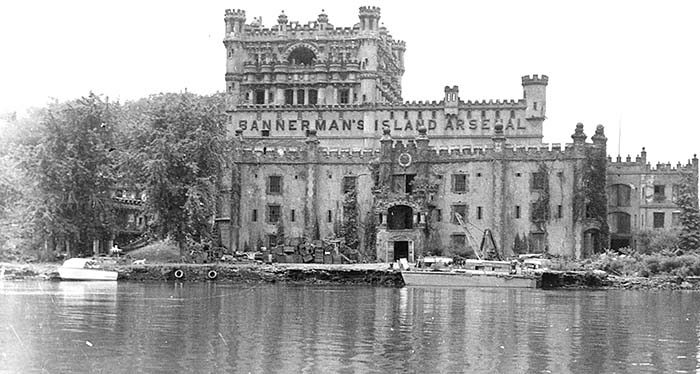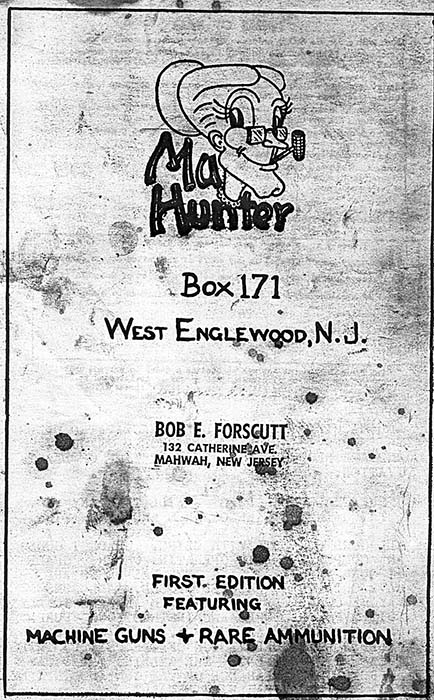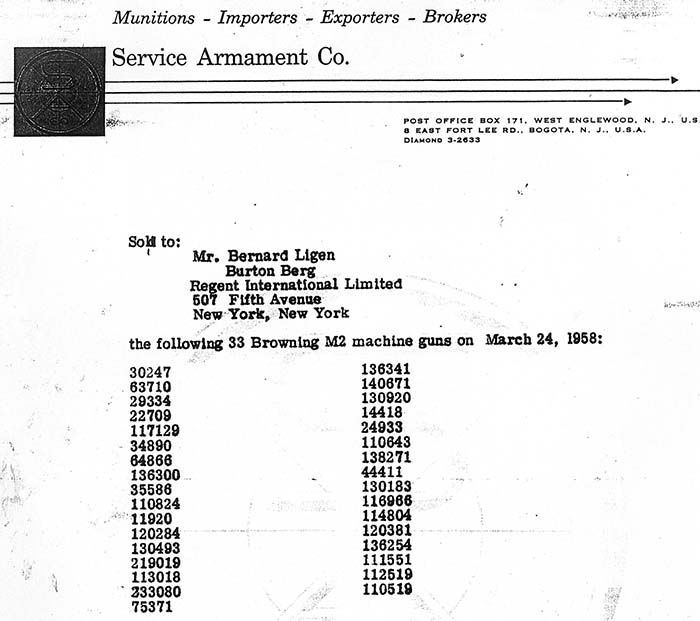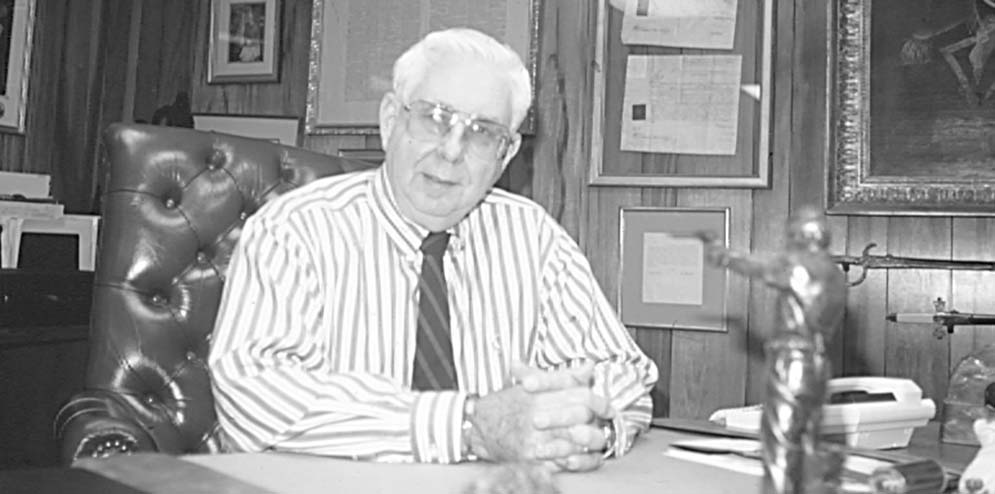By Robert M. Hausman
The roots of today’s heavy interest in full-auto firearms go back a little over 40 years to the mid to late 1950’s, when a young New Jersey engineer (who had been collecting guns since the tender age of 8), decided to turn his life-long interest in firearms into a vocation.
Valmore J. Forgett decided to go into the machine gun field while stationed at Aberdeen Proving Ground as a U.S. Army technical writer. The friendships he had forged with small arms experts, his access to all of the arms records at Aberdeen, and his enthusiasm for gun collecting, all came together to give him the necessary background to enter the business. The large numbers of sub- and machine guns brought back into the country by World War Two and Korean conflict veterans also gave an added incentive.
Forgett began in business in November 1956 by offering Deactivated War Trophies, or DEWATS, as they were classified by the U.S. Treasury Department. Large numbers of veterans who had brought back full-auto arms from overseas were able to avoid paying the steep $200 registration and transfer tax required for a live machine gun, by rendering the guns into a deactivated condition.
Under the terms of the DEWAT classification in those years, any machine gun which had its chamber welded closed so a live round could not be inserted, and had the barrel steel-welded to the frame, under the supervision of a Treasury Dept. revenue agent, thus fell into the DEWAT category which meant there was no tax and the Treasury Department did not have to be notified when a sale was made. The firearm receivers did not have to be registered, as they are today.
Forgett was initially offered a large lot of imported automatic weapons. Realizing their sales potential, the necessary dealer’s licenses were obtained and Forgett’s first ad appeared in The Shotgun News titled simply “Machine Guns.”
The advertisement offered such prized arms as the Thompson submachine gun, the seldom seen United Defense submachine gun, the famous Johnson Light Machine Gun, and several others. While all were DEWAT’s, the triggers would still click and the guns’ bolts could still be moved back and forth. The response was phenomenal! Phone calls, letters and telegrams started to pour in. One dealer called and offered to buy all of the Thompsons but quickly backed off when he heard several thousand were for sale.
Though it is not generally known in the trade, these early shipments of machine guns were actually imported by Sam Cummings, an ex-CIA operative and founder of Interarms (formerly known as Interarmco), of Alexandria, Virginia. Cummings would do the importing (mainly from South and Central America) and Forgett would do the deactivation welding on the guns so he could easily sell the guns in quantity without the buyers having to undergo the rigorous federal approval and tax payment process.
“Ma Hunter”
The next ad Forgett placed in the gun paper appeared under the trade name of, “Ma Hunter, the sweet, lovable old lady who buys and sells machine guns.” Subsequent ads became entertaining as well as informative, and the amount of orders coming in continued to grow. Forgett had turned the DEWAT machine gun business upside down, shattering previous high market prices and offering, in quantity, machine guns that had formerly been very rare. His activities helped machine gun collecting become an established and respected branch of the gun collecting world as the numbers of automatic weapons collectors around the country grew dramatically.
The first edition of the catalog, of which only 100 copies were printed, was produced with a typewriter and contained line drawings of the guns. The cover contained an illustration of the bespectacled “Ma Hunter” herself, with a corn cob pipe in her mouth, big, bright eyes and appealing long eyelashes. The machine guns available were: M1 Thompsons selling for $80; “garden variety” Thompson M1A1’s $75; Johnson Light Machine Guns complete with bipod and magazine at $50; MII air-cooled Browning Light Machine Guns without mount for $60; British .303 caliber Bren Guns, described as the “most popular light machine gun in the world” at $75 for a specimen in “Grade I” condition, and $60 for one in “Grade II” shape.
In the heavy machine gun area, the catalog claimed to offer the world’s only supply of .50 caliber, water-cooled Brownings complete with spade grips. Manufactured by Colt, the guns sold for $50!; a limited number of field mounts for heavy machine guns were available for just $85; and, “nice condition” Vickers .303 caliber water-cooled machine guns complete with mount were sold for only $100. The offerings also included 2-inch Dutch and U.S. 81mm mortars, as well as a variety of surplus ammunition, and miniature black powder cannons.
Forgett’s associate in the machine gun business, Sam Cummings, also operated a mail order firearms firm (in those pre-1968 Gun Control Act days when firearms could still be sold across state lines without federal paperwork) known as Hunter’s Lodge. The firm’s ads, which featured a variety of surplus arms but apparently no full-auto’s, carried a cartoon illustration of “Ye Old Hunter,” a bearded old man wearing a plaid shirt and a wide-brimmed hat with a huge feather stuck in its brim. “Ye Old Hunter,” the reputed proprietor of Hunter’s Lodge, was usually humorously depicted in the process of firing a revolver with a severely bent barrel.
Forgett soon expanded his business by promoting the idea of artillery collecting. Operating with the premise that there were many Americans who would love to have a cannon of their own, he printed up 2,000 copies of his first artillery catalog, betting correctly that many people would at least send in 25 cents to receive the catalog in the mail.
As early as 1957, the then 27-year old Forgett came to the attention of local newspapers for his arms collecting efforts. The September 15, 1957 edition of the Newark, New Jersey Sunday News carried a news item entitled, “Arms Collection Keeps Police Department Alert,” and contained an image of Forgett holding a Thompson submachine gun. The article noted Forgett’s “harmless-looking little warehouse” in Bogota, New Jersey contained: “six anti-tank guns, 30 field cannons, 175 submachine guns, hundreds of rifles and handguns, as well as thousands of live cartridges and shells.
“New York and New Jersey State Police check at the store-house frequently,” Forgett was quoted as saying and added “local police check the premises every 20 minutes, all night long.” Forgett said he was more interested in the history of the weapons than the arms themselves and noted most of his collection was made up of arms used by both sides in World Wars One and Two. The paper noted half of the submachine gun collection at that time was deactivated. Forgett was then employed as a sales representative for his father’s sheet metal firm, Service Welding Co., in Ridgefield, New Jersey and operated his gun business part-time.
In December 1957, Guns and Hunting Goods Merchandiser, a trade publication, profiled Forgett, describing him as, “a fast-rising young machine gun salesman.” About one-third of the guns would be sold to dealers who would sell them to collectors, display them in their store windows as attention-getters or be used as decorations for the gun cabinets of “millionaire gun cranks, by flanking a rich mahogany cabinet with Thompsons. And somewhere in the U.S. there is at least one barbershop sporting a machine gun chained to the back wall,” the magazine said.
Industry Advocacy
In the same trade article, Forgett called for a lowering of the $200 transfer tax on live guns. “In the law under which I do business, the 1954 version of the 1934 National Firearms Act, there are both realistic and unrealistic elements,” he began. “Realistic is the basic fact that an unregulated promiscuous distribution of machine guns is not a good idea. The high tax is one of the most unrealistic things about the law. The average machine gun years ago sold for $200. The tax of $200 was designed to curb trade in these arms completely, by imposing a 100 percent tax on each sale.
“Today, machine guns cost much less, as so many are government surplus stocks of no military value. Sten guns sell for as little as $13 to $17, while Johnson LMGs, Brens, and many varieties of light, medium and heavy Brownings sell for $50 to $75. A tax of $200 on these in working condition does not accomplish the desired end of obtaining registration and payment of tax. Instead, it is so high that the small collector who obtains one from, say, a returned serviceman, simply ignores the law and fails to pay the tax.”
To add some perspective to what $200 could buy during the period, a new Volkswagen “Beetle” automobile could be purchased for about $800, so the federal transfer tax was actually one-quarter the cost of a new car in the 1950’
Noting that at the time, between 40 and 60 percent of the unregistered machine guns in the country were brought in by soldiers returning from World War Two and the Korean conflict, Forgett said, “The effect of the tax is to drive guns underground, rather than get them registered. Despite the Treasury Department’s proclamations encouraging voluntary registration and deactivation, the average GI and collector remains unconvinced they won’t be confronted with a grilling as if he were a mass murderer if he attempts to comply with the law.
“For the average honest citizen to have this fear of the authorities suggests abuses by individual agents in the field, added to inconsistent rulings from the (Treasury’s) central office, plus the originally obscure and vague or inaccurate wording of the law itself, have given the honest citizen something to fear.
“If the Treasury Dept. would settle for a realistic tax figure, retaining the severe penalties for failure to register, an effective firearms control could be established in the machine gun field,” he continued. “And if the Treasury agents would stop acting as if every person with a machine gun was a hopped-up juvenile delinquent spoiling for a gang rumble, or a baby Dillinger lurking by a bank, I think they could count on the assistance of gun collectors and dealers across the nation, rather than their opposition. By dropping the high tax of the machine gun law, the authorities could enlist the help of collectors who are vitally concerned with getting rid of the ‘bad apples’ and keeping shooting and gun collecting, from muzzle loaders to machine guns, a clean sport and a clean business.”
In the late 1950’s, America was a kinder, gentler place for gun owners. Upon learning of a person in possession of an unregistered, live machine gun, Treasury agents would go to the gun owner’s home, and instead of coming in shooting with fully automatic weapons of their own accompanied by flame-throwing tanks, as is sometimes done today, the agents would simply induce the subject to have the live machine gun welded to render it inoperable. Forgett recounted one such incident of the day.
“I’ve known a few such collectors (who kept unregistered fully-automatic arms),” Forgett recalled, “but they’re not gangsters by any means. Among the few I have known were arms factory mechanics and gun designers, including some of the most famous in the business. One collector was a successful grocer, a businessman respected in his community. Then one day, the Treasury came into his house and made him weld up every gun. Resulting publicity was so damaging he ultimately sold his business and moved to another state.”
Forgett soon opened a retail store known as Service Armament Co., the forerunner of today’s Navy Arms Co. operation. It was initially open only in the evenings. The store’s merchandise displays often shocked customers who came in, as it did not have the usual
“sporting” type of merchandise on display.
Unconventional Store
The trade magazine described the shop as follows: “Upon entering the building, instead of the usual array of hunting rifles and shotguns, you see walls lined from floor to ceiling with light machine guns, submachine guns, anti-tank rifles, an occasional bolt action military rifle, and maybe even a .22 rifle or two.”
“On the floor beside the office desk are mortars, .50 caliber machine guns, and other odds and ends too heavy for the wall. Moving through the store you come to a small room containing nothing but ammunition and odd parts. You will not find standard ammo here. Perhaps you need some canister shells for your 37mm cannon. Do you hand load your own
20mm automatic cannon cases? Well, ‘Ma’ has new, primed 20mm cases for sale.
“In the rear of the store, ‘sweet old Ma Hunter’ keeps the field artillery. There were about 25 cannons scattered about the back room. These are genuine obsolete cannon purchased from the Guatemalan government, from revolving 37mm Hotchkiss cannon or a small 2-inch mountain gun to full-size Krupp field artillery. And ‘Ma Hunter’s’ is probably the only place in the world where one can purchase ‘Do It Yourself’ cannon kits. Each kit contains all the external parts needed to assemble a full-size 57mm anti-tank cannon. The 3,000 pound kit is guaranteed to keep you busy on long winter nights,” the magazine predicted.
Castro’s Machine Guns
A major source of machine guns in the late 1950’s was Raritan Arsenal. This government facility released large numbers of fully-automatic arms including Thompsons, M3 “Grease Guns,” Johnson Light Machine Guns and .30 and .50 caliber Brownings. Once the guns had their chambers welded shut under the supervision of a U.S. Treasury agent, all government records on the guns were destroyed as they were now classified as DEWATS, or non-guns.
Some of these deactivated guns from Raritan Arsenal, according to Forgett, wound up in the hands of Fidel Castro’s forces for use in the Cuban Revolution. The deactivated machine guns were reportedly purchased by a New York City-based Central Intelligence Agency (CIA) front organization with funds supplied by the CIA. An upstate New York arms merchant reportedly supplied the CIA with the necessary parts for reactivation. The guns were then shipped to a location in Florida where they were reactivated and shipped to Castro’s forces in Cuba by the CIA, according to Forgett.
Service Armament Co. inadvertently shipped some thirty-three deactivated Browning M2 machine guns on March 24, 1958 to an unnamed individual at Regent International Limited, at 507 Fifth Avenue, New York, New York. Forgett now maintains Regent was operating under the direction of the CIA and the ultimate end users of the guns were actually Fidel Castro’s military forces, after the guns were illegally reactivated by the CIA in Florida and then shipped to Cuba.
In November 1959, Forgett was in the news again when a shipment of arms to his warehouse came under police scrutiny. Forgett bought the entire stock of a firm called Datel Industries in Oconomowoc, Wisconsin, consisting of machine guns, handguns, rifles, bayonets, ammunition, cartridge belts, rifle slings, rifle scopes and cans of powder. The 10-ton shipment by truck to his New Jersey warehouse came to the notice of officials during a routine truck weight inspection in East Cleveland, Ohio, when inspectors found the truck to be two tons overweight. Federal authorities became involved when it was found the truck’s driver had no bill of lading for the goods. The matter was later resolved.
Similarly, in March 1961, a truck carrying Service Armament Co. goods intended for use in Maryland and Virginia celebrations commemorating the 100th anniversary of the Civil War, was stopped by officers in Philadelphia, Pennsylvania for an unlit tail light. When the two policemen approached the vehicle, they noticed the mouth of a cannon sticking out from the cargo area. Upon inspection, they found 50 Mauser rifles, 25 Civil War cannon charges, a box of machine gun parts, a hand grenade, and other armament. The driver was booked on charges of violating Philadelphia’s gun law as he did not have a permit to carry arms and for “failing to have at least two cops escorting him through the city,” according to a newspaper report.
In 1958, learning of the availability of a quantity of Gatling Guns overseas, Forgett announced plans to engage in a Gatling gun match with three other shooters. Each was issued 500 rounds and used Forgett’s vintage 10-barreled hand-cranked piece to take turns firing at a 6-by-6-inch wooden post at 1,000 yards. The gunner who cut the post in half with the least number of rounds won. The idea was to build interest amongst the shooting public in the old crank-operated guns, which Forgett knew he could supply. Forget’s efforts at instilling the shooting of Gatling guns proved successful and in 1959 he traveled to Europe to search arsenals for some of the 1,200 to 1,500 Gatlings that had been manufactured.
In an article appearing in the trade publication, Sporting Goods Retailer, in that year, it was noted only modern Winchester or Remington .45-70 ammo should be used in the Gatling, as the older black powder shells had a tendency to break bolts. One of the Gatling’s virtues was that if one chamber became inoperable, the gun would still fire from its nine other barrels. The magazine noted Remington 405-grain soft point ammo functioned perfectly during tests of a Gatling with Accles drum feed. The gun was invented by Dr. Richard Jordan Gatling, a medical man who is also credited with devising the flush toilet.
River Castle
In September 1958, another business coup came when Forgett was given the opportunity to purchase all of the ammunition stored on the legendary Bannerman’s Island. In an article entitled, “Castle On The River,” the Bergen (New Jersey) Evening Record carried an article on Forgett’s efforts to remove the surpluses of warfare from the former island castle on the Hudson River reached by boat from Putnam County, New York (the castle burned down soon after Forgett removed the materials).

The building, once owned by noted arms merchant Francis Bannerman, had been built on the island to keep its explosive inventory away from population centers. The newspaper described the building as being decorated with cannon balls and pieces of armament, with an over-all appearance like the house visited by Pip in Charles Dickens’ book, Great Expectations, with weeds and vines growing over everything and stretching into the windows.
On the south side of the castle was an irregular red brick path leading to a dry moat, under a portcullis, and to the structure’s upper floors. One section was dubbed the “dungeon.” Pointing north up the river on the 5-1/2 acre island was the cannon from Union Admiral David Farragut’s flagship, the Hartford. Farragut was best known for his command: “Damn the torpedoes. Full steam ahead,” during the Civil War battle of Mobile Bay.
Forgett, and several aides, spent 40 working days deactivating Civil War and other ammunition which was later brought to his New Jersey store and warehouse. To aid in the deactivation, he devised a hand operated machine that pulled apart the shells. The horde included such oddities as Civil War rockets nicknamed, “Whistling Dixie,” for the audible sounds their hollow ends made when propelled through the air.
Muzzleloading Arms
Forgett, who received a degree in mechanical engineering at Clemson University in South Carolina, also became involved in the target matches held by the North-South Skirmish Association, conducted by participants wearing Civil War uniforms. This instilled in him a great interest in muzzleloading firearms. Noting that match participants were using original period firearms, destroying the arms collector’s value by firing them, he hit upon the idea of producing muzzleloading replicas.

In 1957 he visited the major arms factories of Europe. He found the environment in Italy to be ideal for production of replica firearms made by the investment casting method, a cost-effective procedure compared to machining. The investment casting method of firearm production was used very successfully to build Sturm, Ruger & Co.’s business, allowing it to offer quality arms at very reasonable prices.
The first replicas Forgett produced were of the Colt 1851 Navy revolver and thus he named his new company, “Navy Arms,” after his first imported revolver. The seal of the Confederate navy (depicting crossed cannons and a ship’s anchor) was chosen as his company’s logo.
The increasingly restrictive legislative environment for the sale of machine guns and artillery pieces later led Forgett to get out of that end of the business. He focused his concentration on the sales of semi-auto and bolt action military rifles and handguns, as well as muzzleloaders and other historical replicas. Thus, the earlier company names, “Ma Hunter” and “Service Armament Co.” were dropped in favor of the new, Navy Arms Co.

While out of the machine gun business, today Navy Arms still carries a wide variety of surplus and newly manufactured ammo for military firearms. A good selection of surplus military handguns and long guns are also available, as are gun parts, magazines and accessories. The 2,000 square-foot store and a warehouse in Union City, New Jersey employ 29 persons.
Asked what advice he would give aspiring arms merchants of today, the 69-year old Forgett said, “You never get hurt by making a profit.” Known for his easygoing business style and fair dealing, he further added, “The bulls make money, the bears make money, but the pigs get slaughtered.”
Forgett is one of the lucky ones, who was able to live the life he wanted by fulfilling his early boyhood dream. His high school year book listed his life ambition to “import, export guns,” and he has done so on a grand scale.
Navy Arms Co., 689 Bergen Boulevard, Ridgefield, N.J. 07657 Phone (201) 945-2500.
| This article first appeared in Small Arms Review V3N2 (November 1999) |










